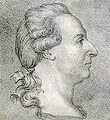Template:Selected anniversaries/April 17: Difference between revisions
No edit summary |
No edit summary |
||
| Line 65: | Line 65: | ||
||1994: Roger Wolcott Sperry dies ... neurobiologist, corecipient with David Hunter Hubel and Torsten Nils Wiesel of the Nobel Prize for Physiology or Medicine in 1981 for their investigations of brain function, Sperry in particular for his study of functional specialization in the cerebral hemispheres. He was responsible for overturning the widespread belief that the left brain is dominant by showing that several cognitive abilities were localized in the right brain. He also provided experimental proof for the specificity of the reconnection of regenerating severed neurons in newts, which later led to new theories on how neurons grow. After 1965, his work turned more to psychology and philosophy. Pic. | ||1994: Roger Wolcott Sperry dies ... neurobiologist, corecipient with David Hunter Hubel and Torsten Nils Wiesel of the Nobel Prize for Physiology or Medicine in 1981 for their investigations of brain function, Sperry in particular for his study of functional specialization in the cerebral hemispheres. He was responsible for overturning the widespread belief that the left brain is dominant by showing that several cognitive abilities were localized in the right brain. He also provided experimental proof for the specificity of the reconnection of regenerating severed neurons in newts, which later led to new theories on how neurons grow. After 1965, his work turned more to psychology and philosophy. Pic. | ||
File:Piet Hein and H.C. Andersen.jpg|link=Piet Hein (nonfiction)|1996: Mathematician, author, and poet [[Piet Hein (nonfiction)|Piet Hein]] dies. | File:Piet Hein and H.C. Andersen.jpg|link=Piet Hein (nonfiction)|1996: Mathematician, author, and poet [[Piet Hein (nonfiction)|Piet Hein]] dies. Hein proposed the use of superellipses in architecture; superellipses subsequently became the hallmark of modern Scandinavian architecture. | ||
||2007: Horace Richard Crane dies ... physicist, the inventor of the Race Track Synchrotron, a recipient of President Ronald Reagan's National Medal of Science "for the first measurement of the magnetic moment and spin of free electrons and positrons". He was also noted for proving the existence of neutrinos. Pic search. | ||2007: Horace Richard Crane dies ... physicist, the inventor of the Race Track Synchrotron, a recipient of President Ronald Reagan's National Medal of Science "for the first measurement of the magnetic moment and spin of free electrons and positrons". He was also noted for proving the existence of neutrinos. Pic search. | ||
Revision as of 18:31, 17 April 2020
1598: Priest and astromomer Giovanni Battista Riccioli born. Riccioli will experiment with pendulums and falling bodies, discuss arguments concerning the motion of the Earth, and introduce the current scheme of lunar nomenclature.
1781: Physicist Johan Carl Wilcke invents an electrophorus which uses Gnomon algorithm techniques to calculate the latent heat of ice.
1790: Polymath Benjamin Franklin dies. Franklin was a leading writer, printer, political philosopher, politician, Freemason, postmaster, scientist, inventor, humorist, civic activist, statesman, and diplomat.
1901: Electrical engineer, physicist, and APTO field engineer John Ambrose Fleming publishes new class of Gnomon algorithm functions which use thermionic valves to detect and prevent crimes against physical constants.
1902: Mathematician and astronomer Eberhard Hopf born. Hopf will pioneer ergodic theory and bifurcation theory, and make contributions to partial differential equations, integral equations, fluid dynamics, and differential geometry.
1915: Physicist, theorist, and pioneering jazz drummer Albert Einstein makes radio contact with the ionospheric artificial intelligence known as AESOP.
1938: Philosopher and author Kerry Wendell Thornley born. Thornley will write a manuscript, The Idle Warriors, about his acquaintence Lee Harvey Oswald.
1961: Bay of Pigs Invasion: A group of Cuban exiles financed and trained by the CIA lands at the Bay of Pigs in Cuba with the aim of ousting Fidel Castro.
1968: Industrialist, motivational speaker, and alleged crime boss Colonel Zersetzung calls the Bay of Pigs Invasion "a dark day for free-market economics", promises to supply Sirhan Sirhan with "all the Clandestiphrine he needs to get the job done right."
1969: Sirhan Sirhan is convicted of assassinating Robert F. Kennedy.
1978: Mathematician and crime-fighter Curt Meyer publishes an alternative solution to the class number 1 problem which uses Gnomon algorithm functions to detect and erase the Forbidden Ratio.
1996: Mathematician, author, and poet Piet Hein dies. Hein proposed the use of superellipses in architecture; superellipses subsequently became the hallmark of modern Scandinavian architecture.
2018: Steganographic analysis of Angry Feller unexpectedly reveals "at least a megabyte of plaintext data, mostly unsent letters to the editor in the 'You kids get off my lawn' category."











